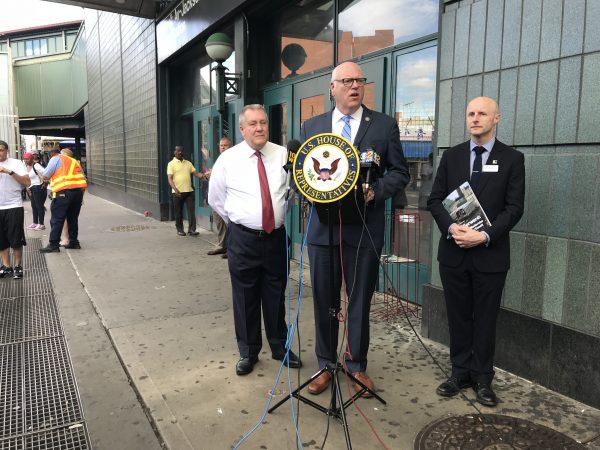
June 19, 2018 By Tara Law
The MTA announced today that it will begin to remove crumbling lead paint and fix structural issues on the elevated 7 line between 82nd Street and 103rd St. next month
The work will take two years to complete at a cost of $43 million, according to NYC Transit Authority President Andrew Byford, who held a press conference at the Roosevelt Avenue-Jackson Heights station this morning.
Upon the completion of the two-year project, the MTA will make similar repairs to the Woodside and Sunnyside sections of the 7 line.
The MTA is hiring specialists to remove the paint “down to the metal,” Byford said. They will then apply three coats of paint and complete structural repairs to the line as necessary,
The MTA has been subject to harsh criticism from residents following a study that found that the crumbling paint contained dangerous levels of lead.
A study by District Council 9 International Union of Painters and Allied Trades found that the paint chips contained lead levels of 244,000 parts per billion–50 times in excess of the legal requirements.
Lead abatement treatment is required when levels reach 5,000 parts per billion.
The lead paint must be removed in stages, Byford said, since there is so much dirt as well.
“It’s not easy because we’re talking about elevated structures… that have decades of lead paint on them, decades of dust and dirt, and this needs to be very, very carefully cleaned off,” said Byford.
Congressman Joseph Crowley, who attended the press conference, said that removing the paint will also help the MTA to see what repairs need to be made to the trestles.
“It’s more than just painting. When you’re painting this line, you see the structural issues up close,” Crowley said. “You can’t just simply paint over old paint….or bad concrete.”
Council Member Danny Dromm, who was also there for the announcement, said that the project will reduce the threat of lead poisoning in the neighborhood.
“It’s not just an aesthetic issue, it’s a ridership issue and a health issue,” said Dromm.
Byford also confirmed that the long-awaited digital communications system, CBTC, will be installed on the 7 train by the end of this year. The signal system will enable the MTA to run trains closer together, and add more trains to the line.

11 Comments

Does this mean the trains will be shut down at these stops? I can’t find any information on this.
Money should be used to get the trains running first!
Is this going to affect any parking spaces? If so we don’t want it.
???
What about the structure in Sunnyside & Woodside from 46th Street towards Main Street? Sunnyside and Woodside is left out of the plan. Have you seen the condition of the elevated structure through Sunnyside & Woodside by 52nd Street and 61 Street Mr. Crowley?
the condition has been the same condition for over a century. it all looks like the slums of a 3rd world country. the trains are even worse. many of the trains i took the past 10 days barely had air conditioning and were literally an oven. i couldn’t wait for the doors to open since it was cooler in the 100 degree weather. mta quality at its finest.
“Upon the completion of the two-year project, the MTA will make similar repairs to the Woodside and Sunnyside sections of the 7 line.”
It’s Crumbelievable
The pigeons will be happy as those are the only ones affected by the lead paint. Wonder how much money district 9 gave Crowley for this gravy train
More good news! Thank God for election years.
Last minute Primary Votes. All politics!